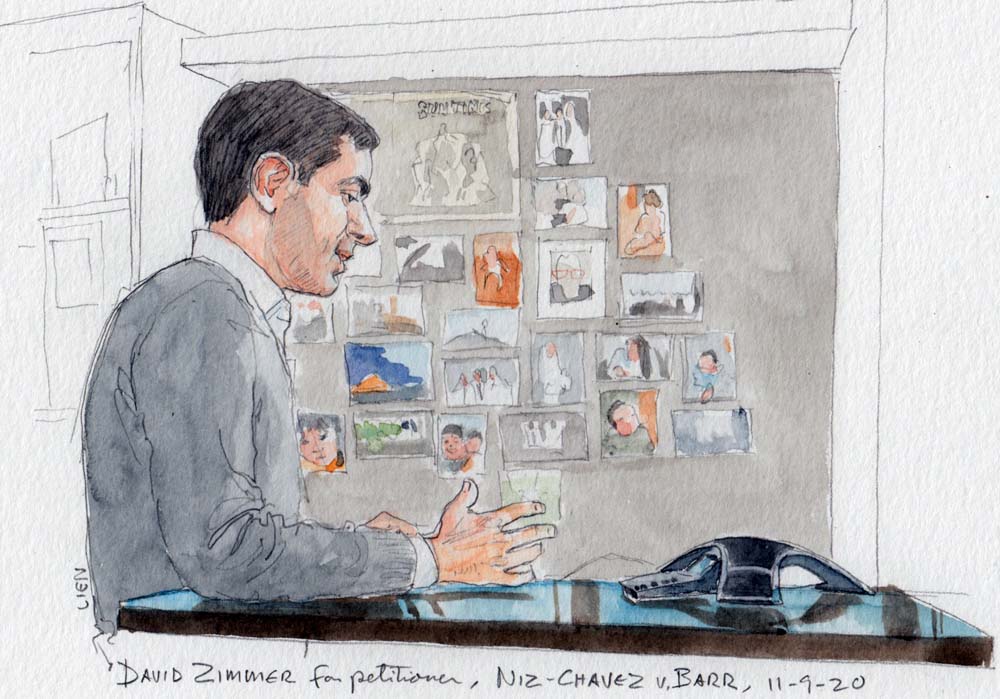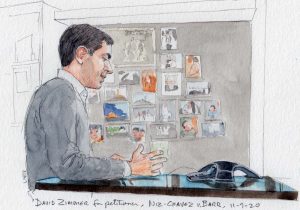Argument analysis: Justices revisit immigration notice provision, parsing statutory text while urging practical solutions

on Nov 10, 2020 at 10:52 pm


David Zimmer, attorney for Agusto Niz-Chavez, calls in to argue (Art Lien)
On Monday morning, the Supreme Court heard oral argument in Niz-Chavez v. Barr, a case that centers on the “stop-time rule,” the same provision of the Immigration and Nationality Act examined by the court in Pereira v. Sessions and Barton v. Barr. The stop-time rule limits access to cancellation of removal, a powerful form of relief for noncitizens who find themselves in removal proceedings. In order to qualify for cancellation of removal, an applicant must have either seven years of continuous residence (for permanent residents) or 10 years of continuous physical presence (for nonpermanent residents). The stop-time rule, as the name suggests, outlines occurrences that stop the seven- and 10-year clocks, rendering noncitizens ineligible for this form of relief.
According to Section 1229b(d) of the INA, one event that triggers the stop-time rule is service upon the noncitizen of “a notice to appear under section 1229(a) of this title.” Section 1229(a)(1), in turn, offers the following guidance regarding notices to appear:
In removal proceedings … written notice (in this section referred to as a “notice to appear”) shall be given in person to the alien … specifying the following: …
(G)(i) The time and place at which the hearing will be held.
The government’s persistent failure to include “time and place” information on notices to appear (formalized as Form I-862 Notice to Appear, or “NTA”) led to the litigation in Pereira. In an 8-1 decision authored by Justice Sonia Sotomayor, the court in Pereira ruled that an NTA lacking date and time information cannot trigger the stop-time rule. Pereira left open the question now raised in Niz-Chavez: whether the government’s service of notice via multiple documents – specifically, an NTA without date and time information, followed by a hearing notice with the time and date – triggers the stop-time rule.
At Monday’s oral argument, attorney David Zimmer, representing Agusto Niz-Chavez, cited both statutory language and legislative history to support the view that Congress intended notice of removal proceedings to be served via a single document. Echoing a core argument in Niz-Chavez’s brief, Zimmer emphasized that Congress intentionally used the article “a” before “notice to appear,” indicating that the required information must be conveyed in one document. Zimmer also walked through the provision’s legislative history, offering that Congress purposefully abandoned a two-step process and replaced it with a comprehensive document: the Notice to Appear. Zimmer urged the court to “give meaning” to this change, asserting that the government’s proposed interpretation would “read that change out of the statute entirely.”
Arguing for the government, Assistant to the Solicitor General Anthony Yang stressed that substance should take precedence over form, and that the “written notice” required by the statute could be provided via more than one document. Justice Clarence Thomas asked Yang to identify other places in the U.S. Code that allow for issuance of multiple notices. Whether intended as a softball or curveball, the question led Yang to concede that he did not have any such examples, but that supplemental notices are not uncommon. Yang also echoed arguments from the government’s brief, offering that Oregon law allows a “notice to arbitrate” – stated in the singular – to be transmitted via multiple documents. Justice Neil Gorsuch later offered Yang a counter example, strongly suggesting that “a bench memorandum” simply could not be conveyed via its component parts.
As they often do, the justices peppered the attorneys with hypotheticals to test the outer bounds of their respective positions. Chief Justice John Roberts asked Zimmer whether the government could provide notice via two documents that arrived on the same day, but in different envelopes. Zimmer insisted that this form of notice would not trigger the stop-time rule, as Congress had created a “clear, firm rule that required that all the information be provided together.” In response to a subsequent question from Roberts, Zimmer ultimately conceded that two separate documents mailed together in the same envelope would probably constitute proper notice under the INA. Yang also faced questions about the form of notice, when Thomas asked whether the government’s position meant that it could potentially send the required notice via “seven or eight or nine different documents.” Yang admitted that nothing “textually limits” that approach, but that the government had no incentive to “balkanize the notice,” given the potential for error.
Justice Samuel Alito pushed Zimmer on whether an overly formalistic position could lead to absurd results. Alito questioned whether the government would be in compliance with the statute if it issued NTAs with the date and time of the hearing, knowing that a very high percentage of the hearings would need to be rescheduled. Zimmer acknowledged that they would, offering that the notice would comport with what Congress intended. Sotomayor sought to counter the sting of Alito’s questions, and invited Zimmer to explain the importance of providing the required information via a single document, even if the date were to later change. As Sotomayor put it, “What was the damage that Congress … was trying to avoid in doing piecemeal notices?” Zimmer mentioned the potential for confusion on the part of noncitizens, as well as administrative problems for the relevant agencies.
Thomas and Justice Brett Kavanaugh seized upon a statutory argument in the government’s brief, noting that “notice to appear” is defined in the provision as “written notice,” and that the latter phrase might reasonably contemplate more than one document. In her back-and-forth with Yang, Justice Elena Kagan responded to this argument with an incisive line of questioning. Kagan asserted that if the phrase “notice to appear” in Section 1229b(d) were replaced with its definition – “written notice”— it would still be preceded by the word “a,” suggesting that a single document must be required. She also pressed Yang on whether a party asked to provide “written notice of appeal” could do so via multiple documents, prompting Yang to respond that precedent actually permitted this, under certain circumstances.
Gorsuch expressed frustration at the fact that the court was even hearing this case, calling it “Pereira Groundhog Day” – suggesting that the court had essentially answered these questions in its prior decision. Gorsuch pressed the point when questioning Yang, noting that the government could have exercised some discretion and “taken the hint from the eight-justice majority in Pereira.” Gorsuch also invited Zimmer to articulate why a 2019 decision of the Board of Immigration Appeals in Matter of Mendoza-Hernandez, which held that notice via multiple documents can trigger the stop-time rule, was not entitled to deference under Chevron v. Natural Resources Defense Council, in which the court articulated that judges should defer to an agency’s reasonable interpretation of an ambiguous statute. Zimmer cited the board’s “unexplained change of position” in Mendoza-Hernandez, arguing that it disregarded the statutory text and history and provided no opportunity for public input.
In her questioning of Zimmer, Kagan offered a solution that appeared to capture the attention of some of the justices. What if the government issued an initial NTA without the date and time information, but then issued the same (or a similar) document with the date and time added? Zimmer conceded that the latter NTA would comply with the statute and trigger the stop-time rule, even if it was not what Congress had anticipated. Justice Amy Coney Barrett suggested, in her questioning of Zimmer, that this might be a superior solution for noncitizens, rather than having the stop-time rule be triggered by an earlier NTA with a “dummy” date. Along these lines, Roberts suggested, while questioning Yang, that the government might simply include a copy of the original NTA when sending the subsequent hearing notice.
These various suggestions seemed to signal the view of some justices that the government could figure out a practical way to comply with the statute without overburdening itself. When pressed on this point by Roberts, Yang offered a lengthy explanation of the logistical difficulties that might ensue, given the location of the physical file and the immigration courts’ reluctance to get involved with what is essentially a prosecutorial function. Yang ultimately relented, conceding that “we’re not saying this can’t be done, but it would be burdensome.” In an exchange with Alito, Yang described additional complications that arise when noncitizens are detained at the border.
By the end of the hour, four justices – Breyer, Gorsuch, Kagan and Sotomayor – had openly expressed skepticism about the government’s reading of the statute. Roberts and Barrett revealed less, but seemed persuaded that the government could sidestep this entire issue by modifying some agency practices. Although few of the justices invoked Pereira as controlling precedent, the court’s decision there – coupled with its seeming reluctance to indulge bureaucratic inefficiencies – could very well lead to another lopsided decision in favor of noncitizens.


